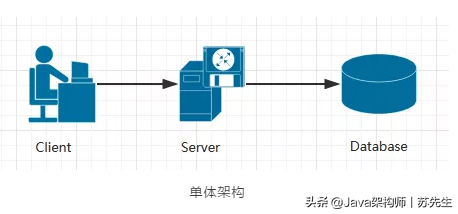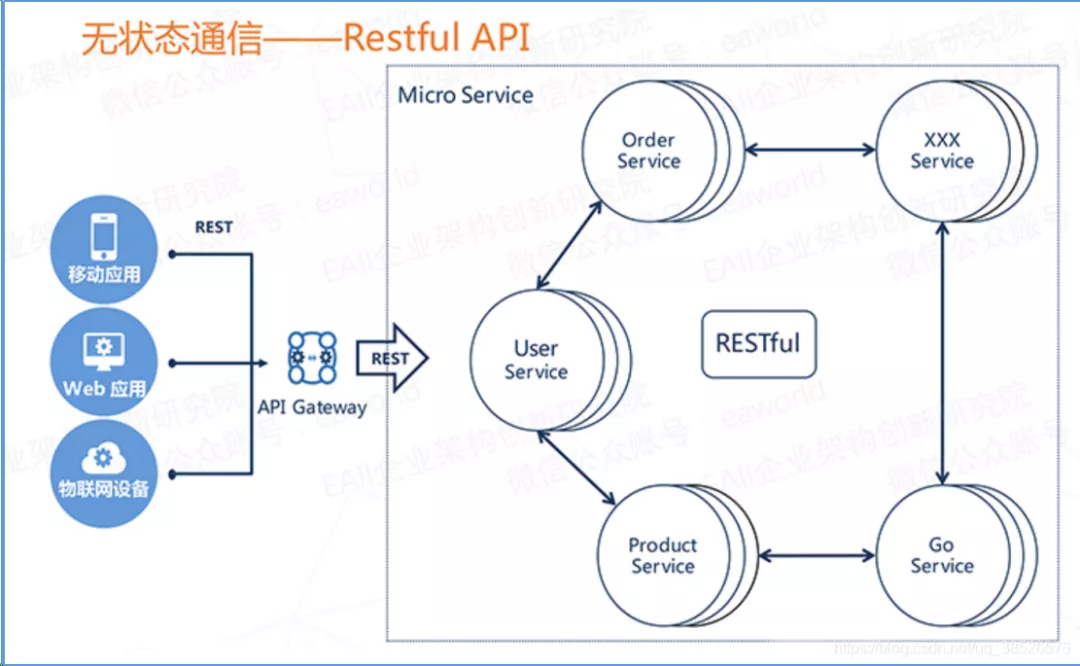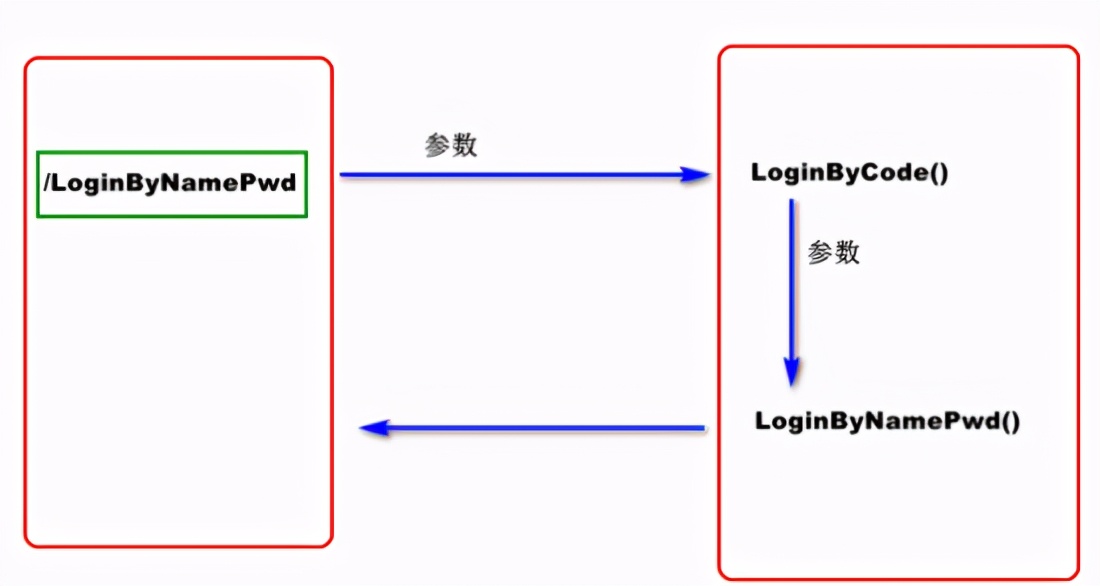我们知道 Spring Boot 给我们带来了一个全新的开发体验,让我们可以直接把 Web 程序打包成 jar 包直接启动,这得益于 Spring Boot 内置了容器,可以直接启动。
本文将以 Tomcat 为例,来看看 Spring Boot 是如何启动 Tomcat 的,同时也将展开学习下 Tomcat 的源码,了解 Tomcat 的设计。
从 Main 方法说起
用过 Spring Boot 的人都知道,首先要写一个 main 方法来启动:
@SpringBootApplication
public class TomcatdebugApplication {
public static void main(String[] args) {
SpringApplication.run(TomcatdebugApplication.class, args);
}
}
我们直接点击run方法的源码,跟踪下来,发现最终的run方法是调用
ConfigurableApplicationContext方法,源码如下:
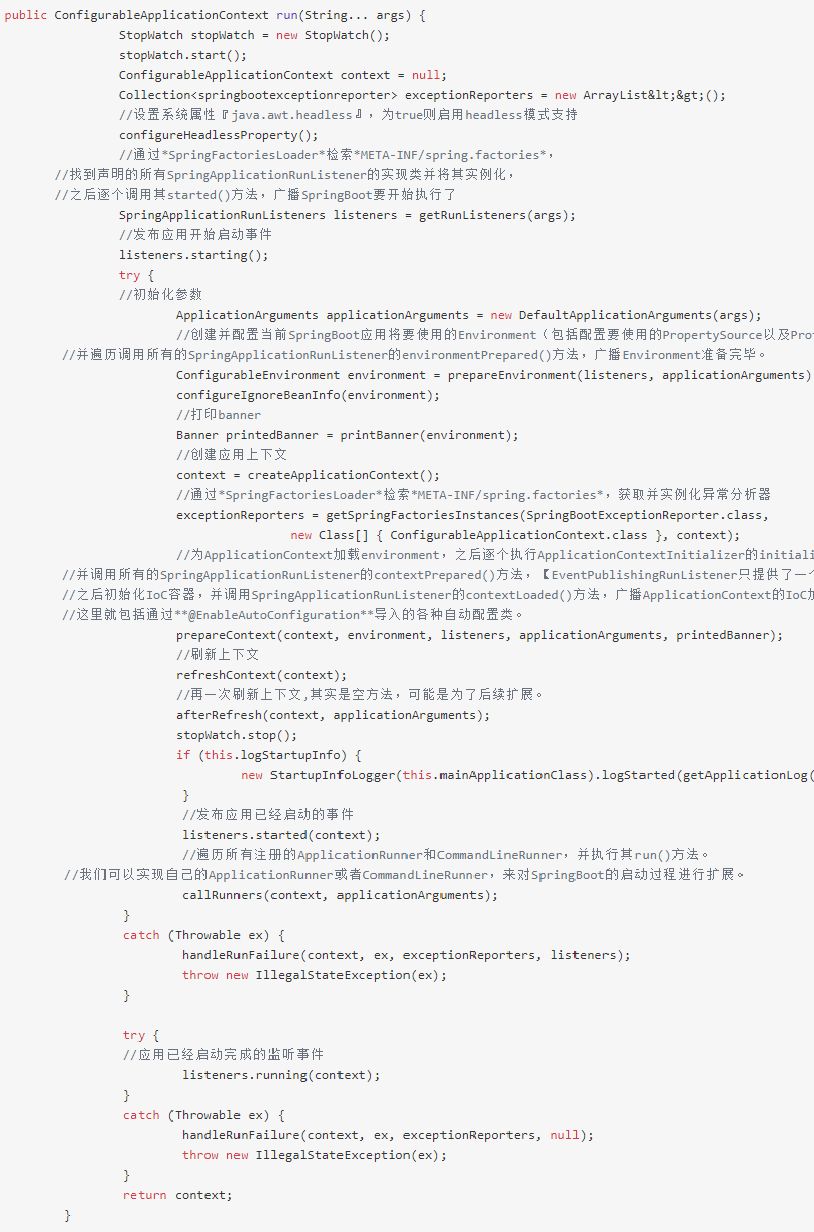
其实这个方法我们可以简单的总结下步骤为 > 1. 配置属性 > 2. 获取监听器,发布应用开始启动事件 > 3. 初始化输入参数 > 4. 配置环境,输出 banner > 5. 创建上下文 > 6. 预处理上下文 > 7. 刷新上下文 > 8. 再刷新上下文 > 9. 发布应用已经启动事件 > 10. 发布应用启动完成事件
其实上面这段代码,如果只要分析 Tomcat 内容的话,只需要关注两个内容即可,上下文是如何创建的,上下文是如何刷新的,分别对应的方法就是createApplicationContext() 和refreshContext(context),接下来我们来看看这两个方法做了什么。
protected ConfigurableApplicationContext createApplicationContext() {
Class<!--?--> contextClass = this.applicationContextClass;
if (contextClass == null) {
try {
switch (this.webApplicationType) {
case SERVLET:
contextClass = Class.forName(DEFAULT_SERVLET_WEB_CONTEXT_CLASS);
break;
case REACTIVE:
contextClass = Class.forName(DEFAULT_REACTIVE_WEB_CONTEXT_CLASS);
break;
default:
contextClass = Class.forName(DEFAULT_CONTEXT_CLASS);
}
}
catch (ClassNotFoundException ex) {
throw new IllegalStateException(
"Unable create a default ApplicationContext, " + "please specify an ApplicationContextClass",
ex);
}
}
return (ConfigurableApplicationContext) BeanUtils.instantiateClass(contextClass);
}
这里就是根据我们的webApplicationType来判断创建哪种类型的 Servlet,代码中分别对应着 Web 类型(SERVLET),响应式 Web 类型(REACTIVE),非 Web 类型(default),我们建立的是Web类型,所以肯定实例化
DEFAULT_SERVLET_WEB_CONTEXT_CLASS
指定的类,也就是
AnnotationConfigServletWebServerApplicationContext类,我们来用图来说明下这个类的关系。
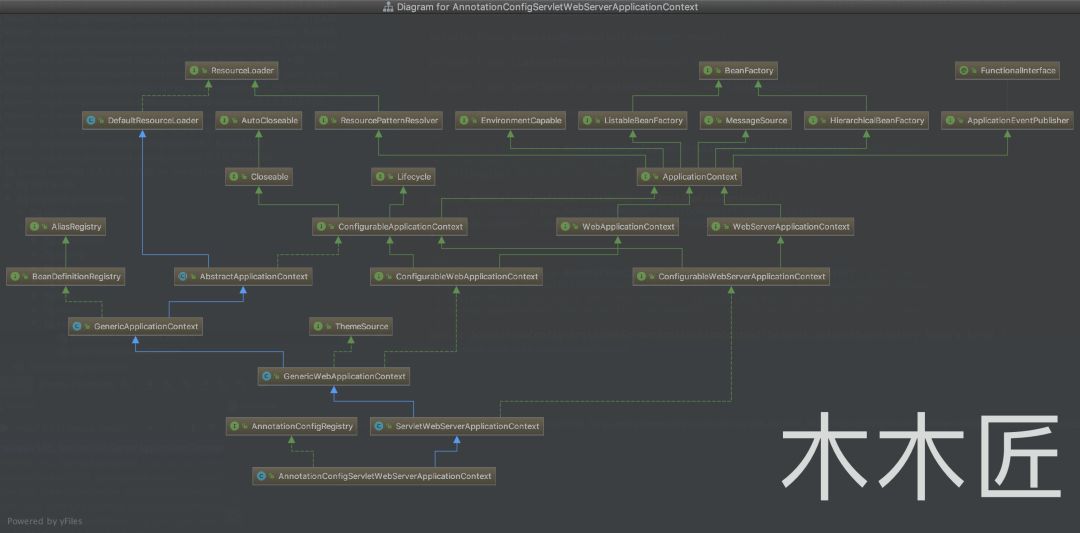
通过这个类图我们可以知道,这个类继承的是
ServletWebServerApplicationContext,这就是我们真正的主角,而这个类最终是继承了AbstractApplicationContext,了解完创建上下文的情况后,我们再来看看刷新上下文,相关代码如下:
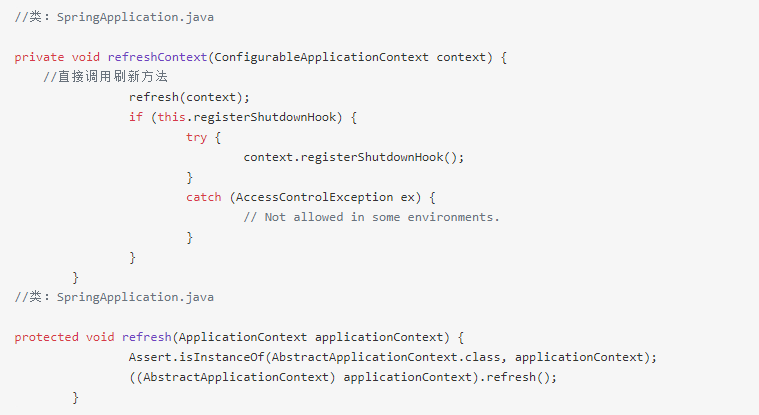
这里还是直接传递调用本类的refresh(context)方法,最后是强转成父类
AbstractApplicationContext调用其refresh()方法,该代码如下:
// 类:AbstractApplicationContext
public void refresh() throws BeansException, IllegalStateException {
synchronized (this.startupShutdownMonitor) {
// Prepare this context for refreshing.
prepareRefresh();
// Tell the subclass to refresh the internal bean factory.
ConfigurableListableBeanFactory beanFactory = obtainFreshBeanFactory();
// Prepare the bean factory for use in this context.
prepareBeanFactory(beanFactory);
try {
// Allows post-processing of the bean factory in context subclasses.
postProcessBeanFactory(beanFactory);
// Invoke factory processors registered as beans in the context.
invokeBeanFactoryPostProcessors(beanFactory);
// Register bean processors that intercept bean creation.
registerBeanPostProcessors(beanFactory);
// Initialize message source for this context.
initMessageSource();
// Initialize event multicaster for this context.
initApplicationEventMulticaster();
// Initialize other special beans in specific context subclasses.这里的意思就是调用各个子类的onRefresh()
onRefresh();
// Check for listener beans and register them.
registerListeners();
// Instantiate all remaining (non-lazy-init) singletons.
finishBeanFactoryInitialization(beanFactory);
// Last step: publish corresponding event.
finishRefresh();
}
catch (BeansException ex) {
if (logger.isWarnEnabled()) {
logger.warn("Exception encountered during context initialization - " +
"cancelling refresh attempt: " + ex);
}
// Destroy already created singletons to avoid dangling resources.
destroyBeans();
// Reset 'active' flag.
cancelRefresh(ex);
// Propagate exception to caller.
throw ex;
}
finally {
// Reset common introspection caches in Spring's core, since we
// might not ever need metadata for singleton beans anymore...
resetCommonCaches();
}
}
}
这里我们看到onRefresh()方法是调用其子类的实现,根据我们上文的分析,我们这里的子类是
ServletWebServerApplicationContext。
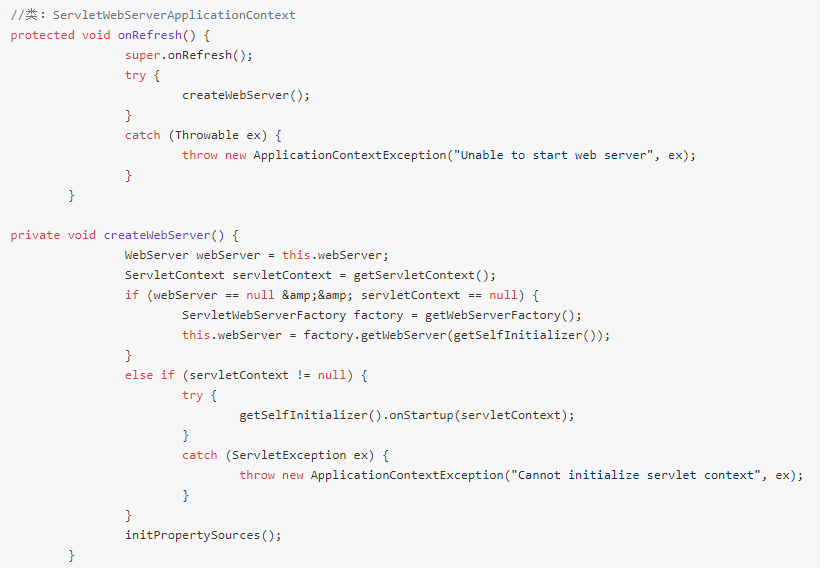
到这里,其实庐山真面目已经出来了,createWebServer()就是启动 Web 服务,但是还没有真正启动 Tomcat,既然webServer是通过ServletWebServerFactory来获取的,我们就来看看这个工厂的真面目。

走进 Tomcat 内部
根据上图我们发现,工厂类是一个接口,各个具体服务的实现是由各个子类来实现的,所以我们就去看看
TomcatServletWebServerFactory.getWebServer()的实现。
@Override
public WebServer getWebServer(ServletContextInitializer... initializers) {
Tomcat tomcat = new Tomcat();
File baseDir = (this.baseDirectory != null) ? this.baseDirectory : createTempDir("tomcat");
tomcat.setBaseDir(baseDir.getAbsolutePath());
Connector connector = new Connector(this.protocol);
tomcat.getService().addConnector(connector);
customizeConnector(connector);
tomcat.setConnector(connector);
tomcat.getHost().setAutoDeploy(false);
configureEngine(tomcat.getEngine());
for (Connector additionalConnector : this.additionalTomcatConnectors) {
tomcat.getService().addConnector(additionalConnector);
}
prepareContext(tomcat.getHost(), initializers);
return getTomcatWebServer(tomcat);
}
根据上面的代码,我们发现其主要做了两件事情,第一件事就是把 Connnctor (我们称之为连接器)对象添加到 Tomcat 中,第二件事就是configureEngine,这连接器我们勉强能理解(不理解后面会述说),那这个Engine是什么呢?我们查看tomcat.getEngine()的源码:
public Engine getEngine() {
Service service = getServer().findServices()[0];
if (service.getContainer() != null) {
return service.getContainer();
}
Engine engine = new StandardEngine();
engine.setName( "Tomcat" );
engine.setDefaultHost(hostname);
engine.setRealm(createDefaultRealm());
service.setContainer(engine);
return engine;
}
根据上面的源码,我们发现,原来这个 Engine 是容器,我们继续跟踪源码,找到Container接口
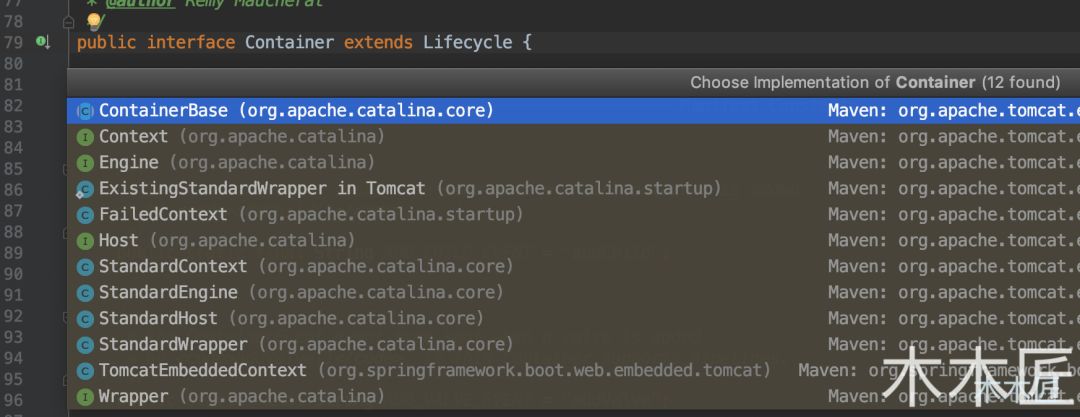
上图中,我们看到了4个子接口,分别是 Engine,Host,Context,Wrapper。我们从继承关系上可以知道他们都是容器,那么他们到底有啥区别呢?我看看他们的注释是怎么说的。
/**
If used, an Engine is always the top level Container in a Catalina
* hierarchy. Therefore, the implementation's <code>setParent()</code> method
* should throw <code>IllegalArgumentException</code>.
*
* @author Craig R. McClanahan
*/
public interface Engine extends Container {
//省略代码
}
/**
* <p>
* The parent Container attached to a Host is generally an Engine, but may
* be some other implementation, or may be omitted if it is not necessary.
* </p><p>
* The child containers attached to a Host are generally implementations
* of Context (representing an individual servlet context).
*
* @author Craig R. McClanahan
*/
public interface Host extends Container {
//省略代码
}
/*** </p><p>
* The parent Container attached to a Context is generally a Host, but may
* be some other implementation, or may be omitted if it is not necessary.
* </p><p>
* The child containers attached to a Context are generally implementations
* of Wrapper (representing individual servlet definitions).
* </p><p>
*
* @author Craig R. McClanahan
*/
public interface Context extends Container, ContextBind {
//省略代码
}
/**</p><p>
* The parent Container attached to a Wrapper will generally be an
* implementation of Context, representing the servlet context (and
* therefore the web application) within which this servlet executes.
* </p><p>
* Child Containers are not allowed on Wrapper implementations, so the
* <code>addChild()</code> method should throw an
* <code>IllegalArgumentException</code>.
*
* @author Craig R. McClanahan
*/
public interface Wrapper extends Container {
//省略代码
}
上面的注释翻译过来就是,Engine是最高级别的容器,其子容器是Host,Host的子容器是Context,Wrapper是Context的子容器,所以这4个容器的关系就是父子关系,也就是Engine>Host>Context>Wrapper。我们再看看Tomcat类的源码:
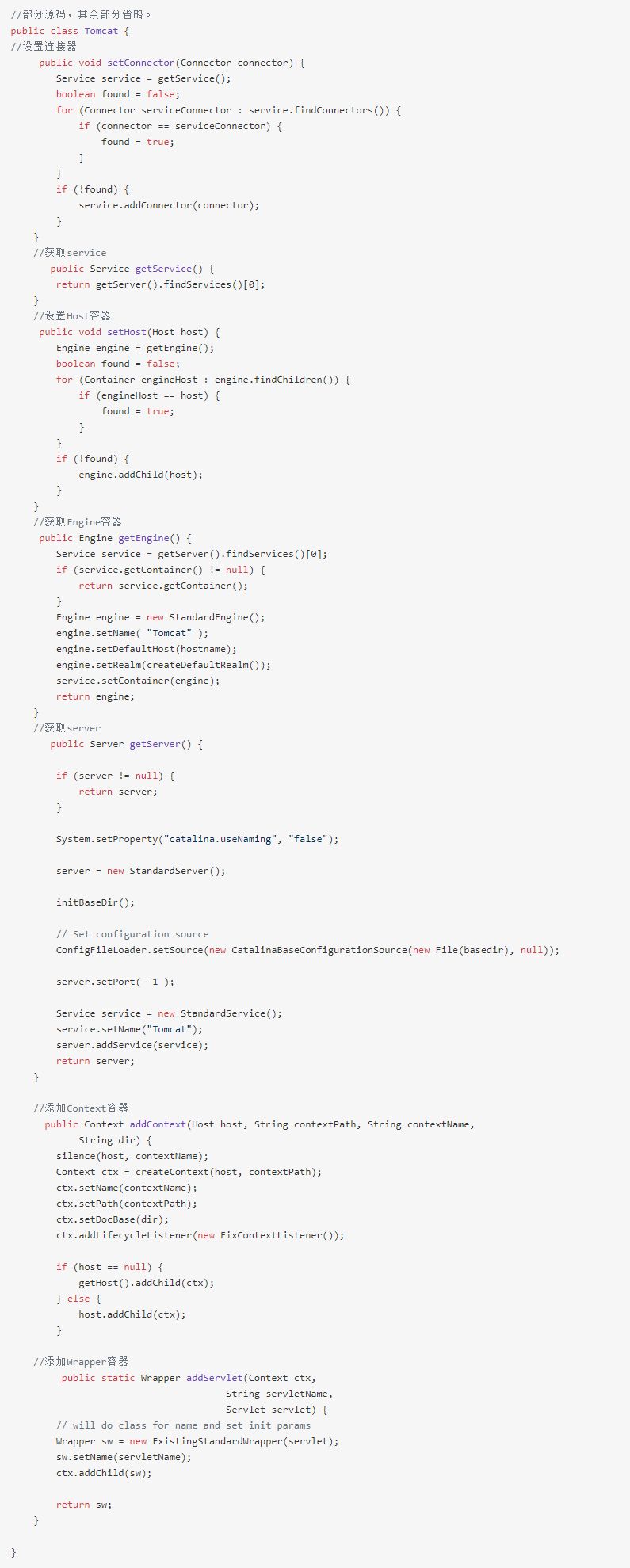
阅读Tomcat的getServer()我们可以知道,Tomcat的最顶层是Server,Server 就是Tomcat的实例,一个Tomcat一个Server;通过getEngine()我们可以了解到 Server 下面是 Service,而且是多个,一个 Service 代表我们部署的一个应用,而且我们还可以知道,Engine容器,一个service只有一个;根据父子关系,我们看setHost()源码可以知道,host容器有多个;同理,我们发现addContext()源码下,Context也是多个;addServlet()表明Wrapper容器也是多个,而且这段代码也暗示了,其实Wrapper和Servlet是一层意思。另外我们根据setConnector源码可以知道,连接器(Connector)是设置在service下的,而且是可以设置多个连接器(Connector)。
根据上面分析,我们可以小结下:Tomcat 主要包含了2个核心组件,连接器(Connector)和容器(Container),用图表示如下:

一个Tomcat是一个Server,一个Server下有多个service,也就是我们部署的多个应用,一个应用下有多个连接器(Connector)和一个容器(Container),容器下有多个子容器,关系用图表示如下:

Engine下有多个Host子容器,Host下有多个Context子容器,Context下有多个Wrapper子容器。
总结
Spring Boot 的启动是通过new SpringApplication()实例来启动的,启动过程主要做如下几件事情:> 1. 配置属性 > 2. 获取监听器,发布应用开始启动事件 > 3. 初始化输入参数 > 4. 配置环境,输出banner > 5. 创建上下文 > 6. 预处理上下文 > 7. 刷新上下文 > 8. 再刷新上下文 > 9. 发布应用已经启动事件 > 10. 发布应用启动完成事件
而启动 Tomcat 就是在第7步中“刷新上下文”;Tomcat 的启动主要是初始化2个核心组件,连接器(Connector)和容器(Container),一个 Tomcat 实例就是一个 Server,一个 Server 包含多个 Service,也就是多个应用程序,每个 Service 包含多个连接器(Connetor)和一个容器(Container),而容器下又有多个子容器,按照父子关系分别为:Engine,Host,Context,Wrapper,其中除了 Engine 外,其余的容器都是可以有多个
